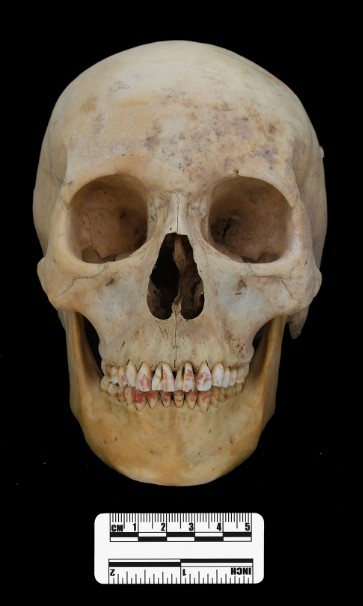The first ever case of an ancient skeleton with cinnabar-stained teeth has been reported in China. Dated to between 2,200 and 2,050 years ago, the young adult female has been dubbed the Red Princess of the Silk Road, and may have been the subject of a shamanic ritual designed to impart immortality.
ADVERTISEMENT
Cinnabar is a toxic mineral consisting of magnesium sulfide, which can cause mercury poisoning when handled improperly. Despite this, the red substance was revered by ancient cultures worldwide, and has been found on the surface of 8,500-year-old ceramics in China.
In 2007, archaeologists began excavating the so-called Shengjindian cemetery in Turpan City, northwest China, where they came across the remains of a high-status individual whose teeth had been dyed red. Using a series of molecular analysis techniques, the authors of a new study have confirmed that the red substance is indeed cinnabar, and that it was applied to the deceased’s teeth using a binder made of animal protein.
“This is the first-and-only known case of cinnabar used as red pigment to stain teeth in antiquity and throughout the world,” write the researchers. “Considering the significance of this discovery, and the potentially high social status of this young female individual, we hereby dubbed her the ‘Red Princess of the Silk Road’” – a nod to the famous cinnabar-tainted Maya tomb of the so-called Red Queen from Palenque, Mexico.
Thought to have been between the ages of 20 and 25 at the time of her death, the mysterious rouge-mouthed lady lived during the Western Han Dynasty, when Turpan acted as a major hub along the thriving Silk Road. Given that no cinnabar mines are known from this region, the study authors suspect that the mineral had been transported along the legendary trade route, and could have come from elsewhere in Asia or even Europe.
Attempting to interpret the meaning of this unique practice, the researchers point out that the color red was associated with local shamanic traditions, some of which revolved around the belief that the human soul resides in the teeth. “As a result, painting the teeth red may be a symbol of immortality,” they suggest.

The young lady lived along the Silk Road at a time when the ancient trade route connected Europe to Asia.
Image courtesy of Dr Qian Wang, Texas A&M University College of Dentistry
Moreover, despite its toxicity, cinnabar is also thought to have been ingested during healing rituals in order to “ease the mind (hypnotize), prolong life, and even kill evil spirits,” say the study authors. “Influenced by shamanic beliefs, cinnabar may serve as a psychoactive drug due to its ability to influence consciousness and aid in communication with gods,” they add.
ADVERTISEMENT
As fascinating as these esoteric explanations may sound, the researchers ultimately state that “since the case in this study is an isolated archaeological phenomenon, it is impossible to pinpoint its exact meaning. However, it is reasonable to suggest that the use of cinnabar in this case might have been for religious, decorative, or medical purposes.”
“This individual with cinnabar-stained teeth might have been involved in the practices of shamanism, even as a patient. Alternatively, they could have used the cinnabar simply for cosmetic beauty,” they conclude.
The study is published in the journal Archaeological and Anthropological Sciences.
Source Link: Meet The "Red Princess Of The Silk Road", Whose Teeth Were Dyed With Toxic Cinnabar